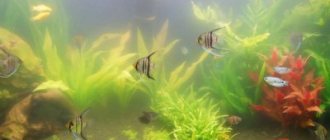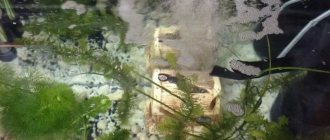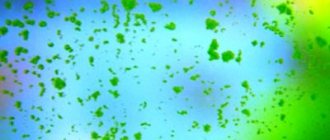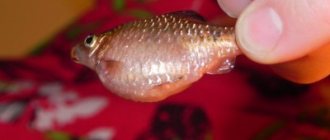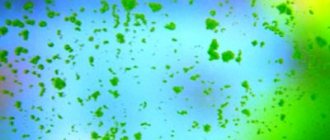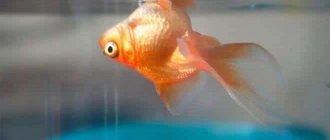Quickly navigate to the article
- 1 The main causes of cloudy water
- 2 How to properly start an aquarium
- 3 How to deal with cloudy water in an aquarium
- 4 Means to combat water turbidity 4.1 Other interesting articles
A problem that every pet fish lover faces is cloudy water in the aquarium. This moment in the future may even cause the death of your fish. To prevent such a sad outcome, it is worth considering what determines the color and density of water in an aquarium and how to deal with cloudiness and contamination of water in a home for pet fish.
What could be the reason?
There may be several reasons why the water in an aquarium takes on a milky tint.
New Aquarium Syndrome
When you first start an aquarium, it takes time to establish balance in it. Beneficial bacteria, plants and other inhabitants have not yet become full participants in the nitrogen cycle.
It proceeds according to the following scheme:
- A high concentration of ammonia is created, which is produced by fish.
- The population of bacteria that process ammonia is increasing.
- Ammonia levels drop, but equally toxic nitrites appear in large quantities.
It is at these stages that the increased concentration of ammonia in the water, and then nitrites, causes the water to turn white.
The cycle ends with the birth of bacteria, which oxidize nitrites, releasing the final product - nitrates . These are no longer such “evil” bacteria, and their level is easily regulated by nature itself.
Bacteria begin to work as a biofilter, simultaneously reducing the whiteness of the aquatic world.
Excessive water changes
Whiteness sometimes causes trouble not only in aquariums with fresh water, but also in well-established aquatic systems.
The reason for this is large volumes of replaced water, usually more than 30%. With this “refreshing” of the aquarium, beneficial bacteria are simply washed away.
As a result, the nitrogen cycle is disrupted, and whitish turbidity appears in the aquarium. One of the important rules of aquarium keeping is not to make a 100% water change unless necessary.
Bacterial outbreak
Another reason for a force majeure situation with the appearance of white turbidity in an established aquarium can be a bacterial outbreak. This is a massive proliferation of bacteria.
The main causes of bakflash:
- excessive portions of food that is not eaten by fish;
- excessive concentration of its inhabitants, inappropriate for the volume of the aquarium;
- overdose of fertilizers;
- absence or malfunction of filtration and oxygen enrichment systems;
- irregular cleaning of the aquarium;
- absence or insufficient soil layer.
Mass proliferation of bacteria
A new aquarium for beginners may also present a problem such as an accelerated growth of bacteria in the aquatic environment. In most cases, the color of the water quickly returns to normal naturally.
Reproduction of bacteria rarely occurs in long-standing aquariums. If this happens under these conditions, this is an indicator of severe organic damage to the ecosystem.
If bacteria multiply in the aquarium, you should urgently move all the inhabitants into a container with clean water. Then you need to clean it, replace the water and wait until biological equilibrium is established in it.
What are the consequences for the fish?
The whitishness of water in an aquarium that does not go away for a long time not only makes its underwater world unsightly, but the reasons for this phenomenon cause significant harm to the fish.
Consequences that result from untimely removal of whiteness in water:
Colonies of bacteria absorb oxygen, and the fish begin to suffocate.- Metabolic products (life activities) of bacteria are poisonous to fish, and without human intervention they can die.
- Nitrites block the transport of oxygen in the circulatory system of fish, and increasing their content to 1.0 mg/l is already fatal for most fish.
- The ammonia that accompanies the phenomenon of whitish water causes burns in fish, especially their delicate gill filaments.
Protecting itself from the burn, the fish begins to secrete mucus. This secretion clogs the gills and prevents her from breathing normally.
When is it necessary to eliminate a nuisance, and when is it not?
You should not show excitement and immediately rush to do something when a whitish tint of water appears in your home pond, in the following cases:
- After starting a new aquarium in the first two weeks, and with a large volume of water - up to four weeks. This is the time required to form a living environment.
- When water is suddenly drained onto unwashed soil and, as a result, small particles and turbidity are washed out of it. After a few days they will settle, and the milky tint of the water will disappear on its own.
Green water
The appearance of a green tint in the water may indicate the active proliferation of microscopic algae. Coping with the elimination of this phenomenon turns out to be much more difficult compared to bacterial blooms.
The most obvious reason is to place the aquarium in an area where there is plenty of direct sunlight. It is an excess of light, even artificial, that can lead to the appearance of green algae.
If no changes are observed after moving, then you should install a good filter for the aquarium, which will rid the aquatic environment of an excess of nitrates and phosphates. These microelements contribute to the active proliferation of algae.
At the first opportunity, it is recommended to analyze the composition of the water. If the test results are positive for the presence of the above substances, it is worth replacing tap water with any available safe analogue. If the reason does not lie in poor water quality, you should slightly reduce the feeding of the aquarium inhabitants with dry mixtures.
What to do if the aquatic environment turns white?
Milky water syndrome can occur both in a new aquarium and in an already established aquatic environment. Despite the fact that the algorithms for combating this scourge are similar in both cases, there are a number of features.
In a new container
To eliminate white water in a starting aquarium, you must:
- Siphon the soil with a soil cleaner.
- Reduce the concentration of fish. Occupancy standards for different species are a separate topic, but they must be known and observed.
- Check the water volumes for compliance and, if necessary, increase the filter power.
You should not clean the filter in a new aquarium - beneficial bacteria are still settling in there.
Turns white in the habitable
The main thing that needs to be done when whitish water appears in an inhabited aquarium is to carry out unscheduled cleaning according to the following algorithm:
Use a soil cleaner to collect all remaining food from the bottom;- wash the filters;
- significantly reduce the diet of the inhabitants of the aquarium; you can completely stop feeding for several days;
- after the water becomes clear, begin to gradually replace it - at first - no more than 20%, with further, over the course of several days, replacements of 10-15%;
- once again siphon the soil from dead microorganisms.
Additionally, to combat whitish water in an old aquarium, you can:
- Cover the bottom with a layer of well-washed coarse quartz sand if fish raise turbidity in search of food.
- Use synthetic padding wool in the internal filter, replacing it daily until the “milk” disappears;
- Launch a large number of snails - ordinary coils. Mobile slipper ciliates that actively live in their mantle are predators in the microcosm. They eat other bacteria and the whiteness will gradually disappear.
- Use a pump filter with a cartridge, popularly known as a “lifesaver for blondes.”
- Apply an aquarium coagulant. It neutralizes organic matter and inorganic impurities dissolved in water.
- Install a UV sterilizer.
Fighting methods
Changes in water hardness can be determined after laboratory analysis of the liquid. Based on the results of the study, experts often make recommendations to minimize the problem. Among the methods of disposal, we will consider 8 popular ones.
Boiling
A method of combating white sediment in water, which is used in hard moisture. The technology makes it possible to soften liquids for drinking and cooking. The advantages of the method include:
- Destruction of the structure of mineral salts. When the water temperature increases to 100 C, sulfates and carbonates precipitate, which allows you to get rid of impurities.
- Disinfection. After boiling, microorganisms in the water die.
- Volatilization of organic compounds. Components with low boiling points evaporate.
In order for the liquid to be suitable for use, the moisture must be separated and carefully filtered from the sediment. After heat treatment, water cannot be stored for longer than a day, otherwise viruses and bacteria will be transferred from the air. In boiled liquid, the concentration of salts increases, which are deposited on the walls of the kettle or pan. If you do not destroy the plaque, the equipment or utensils will quickly become unusable.
How to clear water from plaque Source twimg.com
Freezing
Clean water freezes faster than the option with white sediment. After freezing, liquid remains inside the container, which is drained. After defrosting the ice, structured, soft moisture is obtained, which is beneficial for human and animal health.
The method is very complex and troublesome, so it is not always suitable for constant use at home. To obtain water without white sediment, you need a large tank and a powerful refrigerator. If you pump inaccurately, insoluble salts will get into the defrosted liquid.
Thermal method of removal Source nevseoboi.com.ua
Chemical softeners
Manufacturers of household chemicals offer special substances to combat white residue on dishes and appliances. Descaling products will cope with hard deposits on the walls of a kettle, coffee maker or iron. Softeners for washing machines and dishwashers minimize the negative impact of hard liquids on device parts.
Folk remedies
Chemical or natural substances will help neutralize the destructive effects of mineral salts. A combination of baking soda and citric acid is used to remove white sediment from well water. The method should not be used for cooking or drinking, and the liquid is suitable for household needs.
Decoctions of plants (nettle, flax, chamomile) will help reduce the hardness of moisture for hygiene procedures. Herbal infusions have a positive effect on the structure of the skin and hair, minimizing the negative effects of water with white sediment. The method will not replace pure moisture, but if the well is saline, it will relieve the destructive effects of chemical components.
Folk methods of water softening Source avrorra.com
Oak bark with silicon is a proven way to soften hard liquid from a well or tap. The stones are placed at the bottom of the tank, which is filled with water and left for a week. Wood residues are used for disinfection. White sediment accumulates at the bottom of the container, so carefully drain it.
Preventing the problem from recurring
An experienced aquarist can diagnose a problem that has arisen in a home pond by eye.
But in order to be able to reliably monitor water quality and prevent the reappearance of white suspended matter, it is advisable to have aquarium tests in stock .
They allow you to quickly determine the main indicators that affect water quality:
- carbonate and general hardness;
- content of nitrites and nitrates.
Having dealt with whitish water, it is advisable to monitor these parameters of the aquatic environment for a month and carry out basic preventive measures to prevent the recurrence of white turbidity:
periodically clean the soil and remove rotting plants;- ensure sufficient filtration and purging of water;
- do not overload the aquarium with fish;
- follow the rule of fish compatibility;
- for 1-2 months add only the evaporated volume of water;
- Fill the replacement water at the same temperature as in the aquarium;
- Strictly dose fish feeding.
The main causes of cloudy water
An aquarium is a closed ecosystem with the presence of various organisms and objects that recreate a biological balance that is as natural and favorable as possible for the existence and successful functioning of fish.
If something in this ecosystem is disturbed, the life of the fish is endangered. Cloudiness of the water is a clear and striking sign of an imbalance in the fish’s home. The main causes of cloudy water in an aquarium:
- Overfeeding fish.
- Presence of algae.
- Overpopulation of the aquarium.
- Careless or improper cleaning of the container.
- Poor filtration.
- Errors when starting or filling the aquarium.
- Using the wrong decorations in the container.
If there are algae and other plants in the fish house, they may also be the reason why the water begins to become cloudy. The fact is that they are very sensitive to light.
If there is a deficiency or excess of it, algae can emit an unpleasant odor and cause environmental pollution. So if the answer to the question “why the water in the aquarium begins to become cloudy” is still not found, it is worth paying attention to this factor.
After starting a new home for fish, a huge number of bacteria multiply in the container at high speed, which leads to cloudiness of the liquid. It is impossible to avoid this, even if there is a filter, so after purchasing, do not rush to fill an empty container with water and add pet fish there.
Getting rid of
Every owner of an artificial reservoir, as soon as he notices that the water in an aquarium with fish begins to become cloudy, tries to decide for himself what to do and how to deal with this phenomenon. Considering all the causes of mechanical cloudiness in water, it is necessary to apply the following methods to eliminate this phenomenon.
Carry out a good cleaning of the pond:
- perform a water change;
- siphon the bottom;
- clean all surfaces.
Increase filtering:
- clean and wash the filter;
- install an additional new one or replace both filters with one powerful element.
Turbidity of the water and a green tint of mechanical origin will help remove the filler from the padding polyester; it is placed in the filter instead of a regular sponge. Clear changes will be noticeable within 24 hours.
Another method for removing cloudiness is activated carbon. This absorbent removes pollutants from the pond. The carbon is placed in the filter and left inside for 14 days. The disadvantage of coal is its inability to absorb nitrates and nitrites. The absorbent zeolite will cope with this task. Zeolite is an effective means of combating this problem. The drug is a group of aqueous aluminosilicates of calcium, sodium and minerals with similar composition and properties.
How to properly start an aquarium
It is important to wait a few days before introducing fish into new housing. Thanks to this, most bacteria will simply die out due to lack of food. After this, it is strictly forbidden to change the fluid, otherwise, if you do not want to wait a few days again, cloudiness cannot be avoided.
Before introducing fish into a new house, it also doesn’t hurt to add some water from an old container, where the biological balance is favorable for their life. Particular attention should be paid to laying the soil after purchasing a new container.
Before laying it, it must be thoroughly washed, or better yet several times, and only then placed on the bottom of the container. Otherwise, its particles will disintegrate into small ones and slowly begin to dissolve in the water.
How to deal with cloudy water in an aquarium
So, after these conditions are met, the water in the aquarium still becomes cloudy. What to do in this case? You need to pay attention to feeding the fish. This point may be another reason for answering the question of why the water becomes cloudy.
If the fish do not have time to absorb all the food offered to them, its remains sink to the bottom and eventually dissolve in the water, causing it to quickly become cloudy. Therefore, it is important not to overdo it when feeding. It must be remembered that in the case of fish it is better to underfeed than to overfeed.
Abundance of algae
Overgrowing an aquarium with plants not only leads to the formation of a cloudy environment, but also creates significant discomfort for its inhabitants. Plants create excessive shade in the lower layers. When algae roots rot, they produce a cloudy sediment and even poison the water.
In this case, it is worth thinning out the plants. Old bushes should be pulled out from the ground carefully, along with the roots. In some cases, it is enough just to trim off the excess branches. However, this should be done extremely carefully. After all, when cutting, you can cause even more harm to the ecosystem than with natural rotting and death of plants.
Means to combat water turbidity
So, how to deal with this unpleasant moment. First of all, it is necessary to determine and then eliminate the reasons for the constant turbidity of the main fluid for your fish.
If the cause is overfeeding the fish, you need to reduce the amount of food. If water filtration is poor, buy a better filter or update the old one.
It is worth considering all the points when filling a new fish tank with water, populating the aquarium and when choosing decorations, do not forget to regularly and properly clean the aquarium, pay due attention to the light falling on the “fish house”, the presence and need of algae in the aquarium.
To quickly clean your aquarium you can use:
- Aquarium charcoal.
- Tetra Aqua Crystal Water.
- Sera Aquaria Clear.
Aquarium carbon is poured into the aquarium filter after cleaning and lasts for two weeks. It is an absorbent - a substance that absorbs other substances. It is necessary to clean the aquarium every 14 days, and then replace the carbon in the filter.
The other two products collect small particles in the water (remnants of food, particles of soil) into larger ones, which then settle to the bottom and are removed after cleaning the aquarium or are absorbed through a filter.
